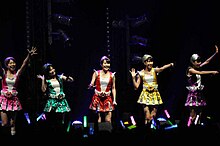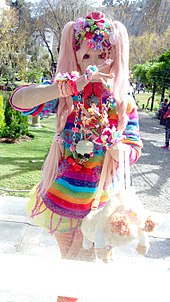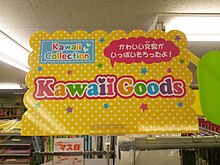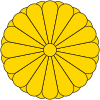Kawaii

Temporary guard rail in Narita, Chiba

E3 Series Shinkansen train with Pokémon decorations
Kawaii (かわいい, pronounced [kaɰaiꜜi]; "lovable", "cute", or "adorable")[1] is the culture of cuteness in Japan.[2][3][4][5] It can refer to items, humans and nonhumans that are charming, vulnerable, shy and childlike.[2] Examples include cute handwriting, certain genres of manga, and Hello Kitty.[6]
The cuteness culture, or kawaii aesthetic, has become a prominent aspect of Japanese popular culture, entertainment, clothing, food, toys, personal appearance and mannerisms.[7]
Contents
1 Etymology
2 History
2.1 Original definition
2.2 Cute handwriting
2.3 Cute merchandise
3 Aesthetics
3.1 Gender performance
3.2 Physical attractiveness
3.3 Idols
3.4 Cute fashion
3.4.1 Lolita
3.4.2 Decora
3.4.3 Kawaii men
3.5 Products
3.5.1 Non-kawaii imports
3.5.2 Industry
4 Influence upon other cultures
4.1 In Asia
5 See also
6 References
7 Further reading
Etymology

Cute manga drawing using kawaii basis (illustration by Daya Wyrd)
The word kawaii originally derives from the phrase 顔映し kao hayushi, which literally means "(one's) face (is) aglow," commonly used to refer to flushing or blushing of the face. The second morpheme is cognate with -bayu in mabayui (眩い, 目映い, or 目映ゆい) "dazzling, glaring, blinding, too bright; dazzlingly beautiful" (ma- is from 目 me "eye") and -hayu in omohayui (面映い or 面映ゆい) "embarrassed/embarrassing, awkward, feeling self-conscious/making one feel self-conscious" (omo- is from 面 omo, an archaic word for "face, looks, features; surface; image, semblance, vestige"). Over time, the meaning changed into the modern meaning of "cute", and the pronunciation changed to かわゆい kawayui and then to the modern かわいい kawaii.[8][9][10] It is most commonly written in hiragana, かわいい, but the ateji, 可愛い, has also been appended. The kanji in the ateji literally translates to "able to love/be loved, can/may love, lovable."
History
Original definition

Kogal girl, identified by her shortened skirt. The soft bag and teddy bear that she carries are part of kawaii.
The original definition of kawaii came from Lady Murasaki's The Tale of Genji, where it referred to pitiable qualities.[11] During the Shogunate period under the ideology of neo-Confucianism, women came to be included under the term kawaii as the perception of women being animalistic was replaced with the conception of women as docile.[11] However, the earlier meaning survives in the modern Standard Japanese adjectival noun かわいそう kawaisō (often written with ateji as 可哀相 or 可哀想) "piteous, pitiable, arousing compassion, poor, sad, sorry" (etymologically from 顔映様 "face / projecting, reflecting, or transmitting light, flushing, blushing / seeming, appearance"). Forms of kawaii and its derivatives kawaisō and kawairashii (with the suffix -rashii "-like, -ly") are used in modern dialects to mean "embarrassing/embarrassed, shameful/ashamed" or "good, nice, fine, excellent, superb, splendid, admirable" in addition to the standard meanings of "adorable" and "pitiable."
Cute handwriting
The rise of cuteness in Japanese culture emerged in the 1970s as part of a new style of writing.[12] Many teenage girls began to write laterally using mechanical pencils.[12] These pencils produced very fine lines, as opposed to traditional Japanese writing that varied in thickness and was vertical.[12] The girls would also write in big, round characters and they added little pictures to their writing, such as hearts, stars, emoticon faces, and letters of the Latin alphabet.[12]
These pictures would be inserted randomly and made the writing difficult to read.[12] As a result, this writing style caused a lot of controversy and was banned in many schools.[12] During the 1980s, however, this new "cute" writing was adopted by magazines and comics and was put onto packaging and advertising.[12]
From 1984 to 1986, Kazuma Yamane (山根一眞, Yamane Kazuma) studied the development of cute handwriting, which he called Anomalous Female Teenage Handwriting, in depth.[12] This type of cute Japanese handwriting has also been called: marui ji (丸い字), meaning "round writing", koneko ji (小猫字), meaning "kitten writing", manga ji (漫画字), meaning "comic writing", and burikko ji (鰤子字), meaning "fake-child writing".[13] Although it was commonly thought that the writing style was something that teenagers had picked up from comics, he found that teenagers had come up with the style themselves, spontaneously, as an underground trend. His conclusion was based on an observation that cute handwriting predates the availability of technical means for producing rounded writing in comics.[12]
Cute merchandise

Kawaii figure
Tomoyuki Sugiyama (杉山奉文, Sugiyama Tomoyuki), author of Cool Japan, says cute fashion in Japan can be traced back to the Edo period with the popularity of netsuke.[14]
Because of this growing trend, companies such as Sanrio came out with merchandise like Hello Kitty. Hello Kitty was an immediate success and the obsession with cute continued to progress in other areas as well. More recently, Sanrio has released kawaii characters with deeper personalities that appeal to an older audience, such as Gudetama and Aggretsuko. These characters have enjoyed strong popularity as fans are drawn to their unique quirks in addition to their cute aesthetics.[15] The 1980s also saw the rise of cute idols, such as Seiko Matsuda, who is largely credited with popularizing the trend. Women began to emulate Seiko Matsuda and her cute fashion style and mannerisms, which emphasized the helplessness and innocence of young girls.[16] The market for cute merchandise in Japan used to be driven by Japanese girls between 15 and 18 years old.[17] No longer limited to teenagers, the spread of making things as cute as possible, even common household items, is embraced by people of all ages.
Aesthetics

Kawaii styled luggage
Soichi Masubuchi (増淵宗一, Masubuchi Sōichi), in his work Kawaii Syndrome, claims "cute" and "neat" have taken precedence over the former Japanese aesthetics of "beautiful" and "refined".[11] As a cultural phenomenon, cuteness is increasingly accepted in Japan as a part of Japanese culture and national identity. Tomoyuki Sugiyama (杉山奉文, Sugiyama Tomoyuki), author of Cool Japan, believes that "cuteness" is rooted in Japan's harmony-loving culture, and Nobuyoshi Kurita (栗田経惟, Kurita Nobuyoshi), a sociology professor at Musashi University in Tokyo, has stated that "cute" is a "magic term" that encompasses everything that is acceptable and desirable in Japan.[18]
Gender performance
Japanese women who feign kawaii behaviors (e.g., high-pitched voice, squealing giggles[19]) that could be viewed as forced or inauthentic are called burikko and this is considered a gender performance.[20] The neologism developed in the 1980s, perhaps originated by comedian Kuniko Yamada (山田邦子, Yamada Kuniko).[20]
Physical attractiveness
In Japan, being cute is acceptable for both men and women. A trend existed of men shaving their legs to mimic the neotenic look. Japanese women often try to act cute to attract men.[21] A study by Kanebo, a cosmetic company, found that Japanese women in their 20s and 30s favored the "cute look" with a "childish round face".[14] Women also employ a look of innocence in order to further play out this idea of cuteness. Having large eyes is one aspect that exemplifies innocence; therefore many Japanese women attempt to alter the size of their eyes. To create this illusion, women may wear large contact lenses, false eyelashes, dramatic eye makeup, and even have an East Asian blepharoplasty, commonly known as double eyelid surgery.[22]
Idols

Momoiro Clover Z performing at Japan Expo
Idols (アイドル, aidoru) are media personalities in their teens and twenties who are considered particularly attractive or cute and who will, for a period ranging from several months to a few years, regularly appear in the mass media, e.g. as singers for pop groups, bit-part actors, TV personalities (tarento), models in photo spreads published in magazines, advertisements, etc. (But not every young celebrity is considered an idol. Young celebrities who wish to cultivate a rebellious image, such as many rock musicians, reject the "idol" label.) Speed, Morning Musume, AKB48, and Momoiro Clover Z are examples of popular idol groups in Japan during the 2000s & 2010s.[23]
Cute fashion
Lolita

Sweet Lolita fashion in Japan
Lolita fashion is a very well-known and recognizable style in Japan. Based on Victorian fashion and the Rococo period, girls mix in their own elements along with gothic style to achieve the porcelain-doll look.[24] The girls who dress in Lolita fashion try to look cute, innocent, and beautiful.[24] This look is achieved with lace, ribbons, bows, ruffles, bloomers, aprons, and ruffled petticoats. Parasols, chunky Mary Jane heels, and Bo Peep collars are also very popular.[25]
Sweet Lolita is a subset of Lolita fashion that includes even more ribbons, bows, and lace, and is often fabricated out of pastels and other light colors. Another subset of Lolita fashion related to "sweet Lolita" is Fairy Kei. Head-dresses such as giant bows or bonnets are also very common, while lighter make-up is also used to achieve a more natural look. Curled hair extensions, sometimes accompanied by eyelash extensions, are also popular in helping with the baby doll look.[26]
Themes such as fruits, flowers and sweets are often used as patterns on the fabrics used for dresses. Purses often go with the themes and are shaped as hearts, strawberries, or stuffed animals. Baby, the Stars Shine Bright is one of the more popular clothing stores for this style and often carries themes. Mannerisms are also important to many Sweet Lolitas. Sweet Lolita is not only a fashion, but also a lifestyle.[26] This is evident in the 2004 film Kamikaze Girls where the main Lolita character, Momoko, drinks only tea and eats only sweets.[27]
Decora

Example of Decora fashion
Decora is a style that is characterized by wearing lots of "decorations" on oneself. It is considered to be self-decoration. The goal of this fashion is to become as vibrant and characterized as possible. People who take part in this fashion trend wear accessories such as multicolor hair pins, bracelets, rings, necklaces, etc. By adding on multiple layers of accessories on an outfit, the fashion trend tends to have a childlike appearance. It also includes toys and multicolor clothes.
Kawaii men
Although kawaii is typically a female-dominated fashion, there are men who decide to partake in this trend. Some men decide to transform themselves into women, more specifically kawaii women. They are able to transform themselves by wearing wigs, false eyelashes, applying makeup, and wearing kawaii female clothing.[28] This is seen predominately in male entertainers, such as Torideta-san, a DJ who transforms himself into a kawaii woman when working at his nightclub.[28]
Japanese pop stars and actors often have longer hair, such as Takuya Kimura of SMAP. Men are also noted as often aspiring to a neotenic look. While it doesn't quite fit the exact specifications of what cuteness means for females, men are certainly influenced by the same societal mores - to be attractive in a specific sort of way that the society finds acceptable.[29] In this way both Japanese men and women conform to the expectations of Kawaii in some way or another.
Products
The concept of kawaii has had an influence on a variety of products, including candy, such as Hi-Chew, Koala's March and Hello Panda. Cuteness can be added to products by adding cute features, such as hearts, flowers, stars and rainbows. Cute elements can be found almost everywhere in Japan, from big business to corner markets and national government, ward, and town offices.[21][30] Many companies, large and small, use cute mascots to present their wares and services to the public. For example:

All Nippon Airways Boeing 747 with a Pokémon livery

JNR Class C11 locomotive repainted as Thomas the Tank Engine, Japan, 2014
Pikachu, a character from Pokémon, adorns the side of ten ANA passenger jets, the Pokémon Jets.
Asahi Bank used Miffy (Nijntje), a character from a Dutch series of children's picture books, on some of its ATM and credit cards.- The prefectures of Japan, as well as many cities and cultural institutions, have cute mascot characters known as yuru-chara to promote tourism. Kumamon, the Kumamoto Prefecture mascot, and Hikonyan, the city of Hikone mascot, are among the most popular.[31]
- The Japan Post "Yū-Pack" mascot is a stylized mailbox;[32] they also use other cute mascot characters to promote their various services (among them the Postal Savings Bank) and have used many such on postage stamps.
- Some police forces in Japan have their own moe mascots, which sometimes adorn the front of kōban (police boxes).
NHK, the public broadcaster, has its own cute mascots. Domokun, the unique-looking and widely recognized NHK mascot, was introduced in 1998 and quickly took on a life of its own, appearing in Internet memes and fan art around the world.
Sanrio, the company behind Hello Kitty and other similarly cute characters, runs the Sanrio Puroland theme park in Tokyo, and painted on some EVA Air Airbus A330 jets as well. Sanrio’s line of more than 50 characters takes in more than $1 billion a year and it remains the most successful company to capitalize on the cute trend.[30]
Cute can be also used to describe a specific fashion sense[33][34] of an individual, and generally includes clothing that appears to be made for young children, apart from the size, or clothing that accentuates the cuteness of the individual wearing the clothing. Ruffles and pastel colors are commonly (but not always) featured, and accessories often include toys or bags featuring anime characters.[30]
Non-kawaii imports

Kawaii goods outlet in 100 yen shop
There have been occasions in which popular Western products failed to meet the expectations of kawaii, and thus did not do well in the Japanese market. For example, Cabbage Patch Kids dolls did not sell well in Japan, because the Japanese considered their facial features to be "ugly" and "grotesque" compared to the flatter and almost featureless faces of characters such as Hello Kitty.[11] Also, the doll Barbie, portraying an adult woman, did not become successful in Japan compared to Takara's Licca, a doll that was modeled after an 11-year-old girl.[11]
Industry
Kawaii has gradually gone from a small subculture in Japan to an important part of Japanese modern culture as a whole. There is an overwhelming amount of modern items featuring kawaii themes, not only in Japan, but worldwide.[35] And characters associated with kawaii have an astounding popularity these days. We can see the "global cute" by the billion-dollar sellers like Pokémon and Hello Kitty.[36] "Fueled by Internet subcultures, Hello Kitty alone has hundreds of entries on eBay, and is selling in more than 30 countries, including Argentina, Bahrain, and Taiwan."[36]
Japan has become a powerhouse in the kawaii industry and images of Doraemon, Hello Kitty, Pikachu, Sailor Moon and Hamtaro are popular in mobile phone accessories. However, Professor Tian Shenliang says that Japan's future is dependent on how much of an impact kawaii brings to humanity.[37]
The Japanese Foreign Ministry has also recognized the power of cute merchandise and have sent three 18-year-old women overseas in the hopes of spreading Japanese culture around the world. The women are dressed in uniforms and maid costumes that are commonplace in Japan.[38]
Kawaii manga and magazines have brought tremendous profit to Japanese press industry.[39] Moreover, the worldwide revenue from the computer game and its merchandising peripherals are closing in on $5 billion, according to a Nintendo press release titled "It's a Pokémon Planet".[36]
Influence upon other cultures
This section 's tone or style may not reflect the encyclopedic tone used on Wikipedia. (July 2013) (Learn how and when to remove this template message) |
Kawaii products are seemingly gaining more popularity beyond the borders of Japan into other Asian markets, and it's seemingly becoming more popular in the US, especially among the young anime and manga fans as well as among those who are influenced by Japanese culture. Cute merchandise and products are especially popular in other parts of East Asia, such as China, Hong Kong, South Korea, Taiwan and Southeast Asian countries like the Philippines, Singapore, Thailand, and Vietnam.[30][40]
Sebastian Masuda, owner of 6%DOKIDOKI and a global advocate for kawaii influence, takes the quality from Harajuku to Western markets in his stores and artwork. The underlying belief of this Japanese designer is that "kawaii" actually saves the world.[41] The infusion of kawaii into other world markets and cultures is achieved by introducing kawaii via modern art; audio, visual, and written media; and the fashion trends of Japanese youth, especially in high school girls.[42]
Japanese kawaii seemingly operates as a center of global popularity due to its association with making cultural productions and consumer products "cute". This mindset pursues a global market,[43] giving rise to numerous applications and interpretations in other cultures.
The dissemination of Japanese youth fashion and "kawaii culture" is usually associated with the Western society and trends set by designers borrowed or taken from Japan.[42] With the emergence of China, South Korea and Singapore as economic centers in Asia, the Kawaii merchandise and product popularity has shifted back to the East. In these Asian markets, the kawaii concept takes on various forms and different types of presentation depending on the target audience.
In Asia

EVA Air Airbus A330 with a Hello Kitty livery
Taiwanese culture, the government in particular, has embraced and elevated kawaii to a new level of social consciousness. The introduction of the A-Bian doll was seen as the development of a symbol to advance democracy and assist in constructing a collective imagination and national identity for Taiwanese people. The A-Bian dolls are kawaii likeness of sports figure, famous individuals, and now political figures that use kawaii images as a means of self-promotion and potential votes.[44] The creation of the A-Bian doll has allowed Taiwanese President Chen staffers to create a new culture where the "kawaii" image of a politician can be used to mobilize support and gain election votes.[45]
Japanese popular "kawaii culture" has had an effect on Singaporean youth. The emergence of Japanese culture can be traced back to the mid-1980s when Japan became one of the economic powers in the world. Kawaii has developed from a few children's television shows to an Internet sensation.[46] Japanese media is used so abundantly in Singapore that youths are more likely to imitate the fashion of their Japanese idols, learn the Japanese language, and continue purchasing Japanese oriented merchandise.[47]
The Asian countries of China, Hong Kong, South Korea, and Thailand either produce kawaii items for international consumption or have websites that cater for kawaii as part of the youth culture in their country. Kawaii has taken on a life of its own, spawning the formation of kawaii websites, kawaii home pages, kawaii browser themes and finally, kawaii social networking pages. While Japan is the origin and Mecca of all things kawaii, artists and businesses around the world are imitating the kawaii theme.[48]
Kawaii has truly become "greater" than itself. The interconnectedness of today's world via the Internet has taken kawaii to new heights of exposure and acceptance, producing a kawaii "movement".[48]
The Kawaii concept has become something of a global phenomenon. The aesthetic cuteness of Japan is very appealing to people globally. The wide popularity of Japanese kawaii is often credited with it being "culturally odorless". The elimination of exoticism and national branding has helped kawaii to reach numerous target audiences and span every culture, class, and gender group.[49] The palatable characteristics of kawaii have made it a global hit, resulting in Japan's global image shifting from being known for austere rock gardens to being known for "cute-worship".[14]
In 2014 the Collins English Dictionary in the United Kingdom entered "kawaii" into their then latest edition, defining as a "Japanese artistic and cultural style that emphasizes the quality of cuteness, using bright colours and characters with a childlike appearance."[50]
See also
| Wikiquote has quotations related to: Kawaii |
- Aegyo
- Chibi (slang)
- Culture of Japan
Kawaii metal, Kawaii bass (Music genre)- Moe
- Yuru-chara
References
^ The Japanese Self in Cultural Logic, by Takei Sugiyama Libre, c. 2004 University of Hawaii Press, .mw-parser-output cite.citation{font-style:inherit}.mw-parser-output .citation q{quotes:"""""""'""'"}.mw-parser-output .citation .cs1-lock-free a{background:url("//upload.wikimedia.org/wikipedia/commons/thumb/6/65/Lock-green.svg/9px-Lock-green.svg.png")no-repeat;background-position:right .1em center}.mw-parser-output .citation .cs1-lock-limited a,.mw-parser-output .citation .cs1-lock-registration a{background:url("//upload.wikimedia.org/wikipedia/commons/thumb/d/d6/Lock-gray-alt-2.svg/9px-Lock-gray-alt-2.svg.png")no-repeat;background-position:right .1em center}.mw-parser-output .citation .cs1-lock-subscription a{background:url("//upload.wikimedia.org/wikipedia/commons/thumb/a/aa/Lock-red-alt-2.svg/9px-Lock-red-alt-2.svg.png")no-repeat;background-position:right .1em center}.mw-parser-output .cs1-subscription,.mw-parser-output .cs1-registration{color:#555}.mw-parser-output .cs1-subscription span,.mw-parser-output .cs1-registration span{border-bottom:1px dotted;cursor:help}.mw-parser-output .cs1-ws-icon a{background:url("//upload.wikimedia.org/wikipedia/commons/thumb/4/4c/Wikisource-logo.svg/12px-Wikisource-logo.svg.png")no-repeat;background-position:right .1em center}.mw-parser-output code.cs1-code{color:inherit;background:inherit;border:inherit;padding:inherit}.mw-parser-output .cs1-hidden-error{display:none;font-size:100%}.mw-parser-output .cs1-visible-error{font-size:100%}.mw-parser-output .cs1-maint{display:none;color:#33aa33;margin-left:0.3em}.mw-parser-output .cs1-subscription,.mw-parser-output .cs1-registration,.mw-parser-output .cs1-format{font-size:95%}.mw-parser-output .cs1-kern-left,.mw-parser-output .cs1-kern-wl-left{padding-left:0.2em}.mw-parser-output .cs1-kern-right,.mw-parser-output .cs1-kern-wl-right{padding-right:0.2em}
ISBN 0-8248-2840-2, p. 86.
^ ab Kerr, Hui-Ying (23 November 2016). "What is kawaii – and why did the world fall for the ‘cult of cute’?", The Conversation.
^ "kawaii", Oxford Dictionaries Online.
^ かわいい - kawaii - 可愛い - cute Japanesefile. Accessed May 7, 2011 from http://japanesefile.com/Adjectives/kawaii_3.html
^ Kim, T. Beautiful is an Adjective. Accessed May 7, 2011, from http://www.guidetojapanese.org/adjectives.html
^ Okazaki, Manami and Johnson, Geoff (2013). Kawaii!: Japan's Culture of Cute. Prestel, p. 8.
^ Diana Lee, "Inside Look at Japanese Cute Culture" (September 1, 2005).
^ かわいい. 語源由来辞典 (Dictionary of Etymology) (in Japanese). Retrieved 20 September 2014.
^ 可愛い. デジタル大辞泉 (Digital Daijisen) (in Japanese). Retrieved 20 September 2014.
^ 可愛いとは. 大辞林第3版(Daijirin 3rd Ed.) (in Japanese). Retrieved 20 September 2014.
^ abcde Shiokawa. "Cute But Deadly: Women and Violence in Japanese Comics". Themes and Issues in Asian Cartooning: Cute, Cheap, Mad and Sexy. Ed. John A. Lent. Bowling Green, Kentucky: Bowling Green State University Popular Press, 1999. 93–125.
ISBN 0-87972-779-9.
^ abcdefghi Kinsella, Sharon. 1995. "Cuties in Japan" [1] accessed August 1, 2009.
^ Skov, L. (1995). Women, media, and consumption in Japan. Hawai'i Press, USA.
^ abc TheAge.Com: "Japan smitten by love of cute" http://www.theage.com.au/news/people/cool-or-infantile/2006/06/18/1150569208424.html
^ "The New Breed of Kawaii – Characters Who Get Us". UmamiBrain. Retrieved 29 September 2017.
^ See "Archived copy". Archived from the original on 2010-11-24. Retrieved 2009-02-12.CS1 maint: Archived copy as title (link) URL accessed February 11, 2009.
^ Time Asia: Young Japan: She's a material girl http://www.time.com/time/asia/asia/magazine/1999/990503/style1.html
^ Quotes and paraphrases from: Yuri Kageyama (June 14, 2006). "Cuteness a hot-selling commodity in Japan". Associated Press.
^ Merry White (29 September 1994). The material child: coming of age in Japan and America. University of California Press. p. 129. ISBN 978-0-520-08940-2. Retrieved 19 July 2011.
^ ab "You are doing burikko!: Censoring/scrutinizing artificers of cute femininity in Japanese," Laura Miller in Japanese Language, Gender, and Ideology: Cultural Models and Real People, edited by Janet Shibamoto Smith and Shigeko Okamoto, Oxford University Press, 2004. In Japanese.
^ ab Bloomberg Businessweek, "In Japan, Cute Conquers All".
^ RiRi, Madame. "Some Japanese customs that may confuse foreigners". Japan Today. Retrieved 25 March 2013.
^ "Momoiro Clover Z dazzles audiences with shiny messages of hope". The Asahi Shimbun. 2012-08-29. Archived from the original on 2013-10-24.
^ ab Fort, Emeline (2010). A Guide to Japanese Street Fashion. 6 Degrees.
^ Holson, Laura (13 March 2005). "Gothic Lolitas: Demure vs. Dominatrix". New York Times.
^ ab Fort, Emmeline (2010). A Guide to Japanese Street Fashion. 6 Degrees.
^ Mitani, Koki. "Kamikaze Girls". IMDB.
^ ab Suzuki, Kirin. "Makeup Changes Men". Tokyo Kawaii, Etc. Archived from the original on 21 July 2013. Retrieved 11 April 2013.
^ Bennette, Colette (18 November 2011). "It's all Kawaii: Cuteness in Japanese Culture". CNN. Retrieved 11 April 2013.
^ abcd "Cute Inc". WIRED. December 1999.
^ "Top Ten Japanese Character Mascots". Finding Fukuoka. 2012-01-13. Retrieved 2013-12-12.
^ Japan Post site showing mailbox mascot Archived 2006-02-21 at the Wayback Machine URL accessed April 19, 2006.
^ Time Asia: "Arts: Kwest For Kawaii". Retrieved on 2006-04-19 from http://www.time.com/time/asia/arts/magazine/0,9754,131022,00.html.
^ The New Yorker "FACT: SHOPPING REBELLION: What the kids want". Retrieved on 2006-04-19 from http://www.newyorker.com/fact/content/?020318fa_FACT.
^ (Research Paper) Kawaii: Culture of Cuteness Archived 2013-01-18 at the Wayback Machine
^ abc Roach, Mary. "Cute Inc." Wired Dec. 1999. 01 May 2005 https://www.wired.com/wired/archive/7.12/cute_pr.html
^ 卡哇伊熱潮 扭轉日本文化 Archived 2013-03-01 at the Wayback Machine
^ "日本的"卡哇伊文化"_中国台湾网". Retrieved 5 July 2018.
^ 王力. ""萌文化"在日本大行其道_旅游_环球网". go.huanqiu.com. Retrieved 5 July 2018.
^ "Cute Power!". 7 November 1999. Retrieved 5 July 2018.
^ (Kataoka, 2010)
^ ab Tadao, T. (n.d). "Dissemination of Japanese Young Fashion and Culture to the World-Enjoyable Japanese Cute (Kawaii) Fashions Spreading to the World and its Meaning". Sen-I Gakkaishi, 66(7), pp. 223–226. Retrieved from: http://search.ebscohost.com/
^ Brown, J. (2011). Re-framing "Kawaii": Interrogating Global Anxieties Surrounding the Aesthetic of 'Cute' in Japanese Art and Consumer Products. International Journal of the Image, 1(2), 1. Retrieved from: http://search.ebscohost.com/
^ [1]A-Bian Family. http://www.akibo.com.tw/home/gallery/mark/03.htm
^ Chuang, Y. C. (2011, September). "Kawaii in Taiwan politics". International Journal of Asia-Pacific Studies, 7(3). 1–16. Retrieved from here
^ [2]All things Kawaii. http://www.allthingskawaii.net/links/
^ Hao, X., Teh, L.L. (2004). "The impact of japanese popular culture on the Singaporean youth". Keio Communication Review, 24. 17–32. Retrieved from: http://www.mediacom.keio.ac.jp/publication/pdf2004/review26/3.pdf
^ ab Rutledge, B. (2010, October). I love kawaii. Ibuki Magazine. 1–2. Retrieved from: http://ibukimagazine.com/lifestyle-/other-trends/212-i-love-kawaii
^ Shearin, M. (2011, October). Triumph of kawaii. William & Mary ideation. Retrieved from: http://www.wm.edu/research/ideation/ideation-stories-for-borrowing/2011/triumph-of-kawaii5221.php
^ "Kawaii culture in the UK: Japan's trend for cute". BBC. 24 October 2014. Retrieved 26 October 2014.
Further reading
.mw-parser-output .refbegin{font-size:90%;margin-bottom:0.5em}.mw-parser-output .refbegin-hanging-indents>ul{list-style-type:none;margin-left:0}.mw-parser-output .refbegin-hanging-indents>ul>li,.mw-parser-output .refbegin-hanging-indents>dl>dd{margin-left:0;padding-left:3.2em;text-indent:-3.2em;list-style:none}.mw-parser-output .refbegin-100{font-size:100%}
Harris, Daniel (2001). Cute, quaint, hungry, and romantic: the aesthetics of consumerism. Boston, Massachusetts: Da Capo. ISBN 9780306810473.
Brehm, Margrit (editor) (2002). The Japanese experience: inevitable. Ostfildern-Ruit, Germany New York, New York: Hatje Cantz; Distributed Art Publishers. ISBN 9783775712545.CS1 maint: Extra text: authors list (link)
Cross, Gary (2004). The cute and the cool: wondrous innocence and modern American children's culture. Oxford New York: Oxford University Press. ISBN 9780195156669.
Carpi, Giancarlo (2012). Gabriels and the Italian cute nymphet. Milan: Mazzotta. ISBN 9788820219932.
Nittono, Hiroshi; Fukushima, Michiko; Yano, Akihiro; Moriya, Hiroki (September 2012). "The power of kawaii: viewing cute images promotes a careful behavior and narrows attentional focus". PLOS ONE. 7 (9): e46362. doi:10.1371/journal.pone.0046362. PMC 3458879. PMID 23050022.
Asano-Cavanagh, Yuko (October 2014). "Linguistic manifestation of gender reinforcement through the use of the Japanese term kawaii". Gender and Language. 8 (3): 341–359. doi:10.1558/genl.v8i3.341.
